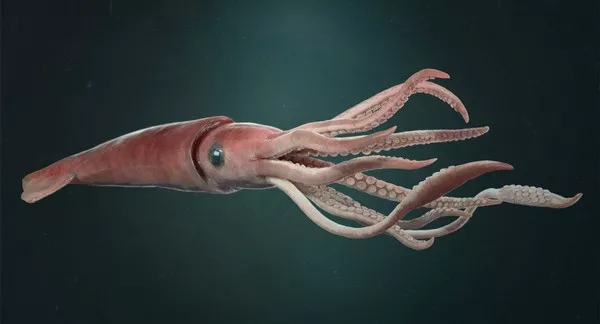Cephalopods, a class of marine animals characterized by their tentacles and well-developed heads, encompass a diverse array of species ranging from the diminutive octopus to the awe-inspiring giant squid. Among these remarkable creatures, the giant squid stands out as one of the most enigmatic and formidable inhabitants of the deep ocean. In this comprehensive article, we delve into the fascinating world of the giant squid, exploring its biology, behavior, and the ongoing quest to unravel its mysteries.
Introduction to the Giant Squid
The giant squid, scientifically known as Architeuthis dux, is a species of deep-sea cephalopod renowned for its immense size and elusive nature. With its massive mantle, long tentacles equipped with powerful suction cups, and distinctive large eyes, the giant squid cuts a formidable figure in the dark depths of the ocean.
Anatomy of the Giant Squid
The anatomy of the giant squid is a testament to its status as a true titan of the deep. At the center of its body is a large mantle, or main body cavity, which houses vital organs such as the heart, gills, and digestive system. From the mantle extend eight long arms, each lined with rows of powerful suckers used for capturing prey and manipulating objects in its environment. In addition to its arms, the giant squid possesses two elongated feeding tentacles equipped with sharp hooks, which it uses to grasp and subdue its prey.
One of the most striking features of the giant squid is its enormous eyes, which are among the largest in the animal kingdom. These eyes are adapted to function in the low-light conditions of the deep ocean, allowing the squid to detect even the faintest traces of bioluminescence emitted by its prey.
Habitat and Distribution
The giant squid is a denizen of the deep ocean, inhabiting the mesopelagic and bathypelagic zones at depths ranging from 300 to 1,000 meters or more. Its distribution is widespread, with sightings reported in all of the world’s oceans, from the icy waters of the Arctic to the temperate seas of the Southern Hemisphere. Despite its global presence, the giant squid remains elusive and rarely encountered by humans due to its deep-sea habitat and nocturnal behavior.
Feeding and Predatory Behavior
As a formidable predator of the deep, the giant squid primarily preys on fish and other cephalopods, including smaller squid and octopuses. Using its long tentacles and powerful suckers, the squid captures its prey with lightning speed, ensnaring them in a lethal embrace before delivering a paralyzing bite with its sharp beak.
The hunting strategy of the giant squid is shrouded in mystery, with much of its behavior observed only through indirect evidence and rare encounters with specimens caught in fishing nets or washed ashore. However, scientists believe that the giant squid employs a combination of stealth, agility, and ambush tactics to capture its prey in the dark depths of the ocean.
Reproduction and Life Cycle
Despite its formidable size and ferocious appearance, the giant squid is a remarkably elusive creature when it comes to its reproductive biology. Like other cephalopods, the giant squid is thought to be semelparous, meaning that it reproduces only once in its lifetime before perishing shortly thereafter.
The mating behavior of the giant squid remains a subject of speculation, with limited observations suggesting that mating may occur in deep-sea aggregations known as “sperm banks.” After mating, the female giant squid produces thousands of gelatinous egg capsules, which she releases into the water column. These capsules drift in the ocean currents, eventually hatching into tiny squid larvae known as paralarvae.
The early life stages of the giant squid are poorly understood, with much of its larval development taking place in the deep sea. As the paralarvae grow and mature, they undergo a series of metamorphoses before eventually assuming the adult form of the giant squid.
Encounters with Humans
Throughout history, the giant squid has captured the imagination of sailors, scientists, and storytellers alike. Tales of colossal sea monsters lurking in the depths have fueled legends and folklore for centuries, with the giant squid often depicted as a fearsome creature capable of dragging ships and sailors to their watery demise.
In recent years, advances in technology and deep-sea exploration have provided unprecedented opportunities to study the giant squid in its natural habitat. Remote-operated vehicles (ROVs) equipped with high-definition cameras have captured mesmerizing footage of giant squid in the wild, offering insights into their behavior and biology.
Challenges and Conservation
Despite its iconic status, the giant squid faces numerous challenges in the modern world. Habitat degradation, overfishing, and climate change threaten the delicate balance of marine ecosystems, potentially impacting the abundance and distribution of giant squid populations worldwide.
Conservation efforts aimed at protecting the giant squid and its deep-sea habitat are critical for ensuring the long-term survival of this magnificent species. By promoting sustainable fishing practices, establishing marine protected areas, and supporting scientific research, we can work together to safeguard the future of the giant squid and other vulnerable marine species.
See Also: The Heaviest Elephant In The World
Conclusion
In conclusion, the giant squid stands as a remarkable testament to the wonders of the ocean and the mysteries that lie beneath its surface. With its immense size, otherworldly appearance, and elusive nature, the giant squid continues to captivate the imagination of scientists and enthusiasts alike. As we strive to unlock the secrets of the deep, the giant squid serves as a powerful reminder of the awe-inspiring beauty and complexity of marine life. Through research, conservation, and appreciation for the natural world, we can ensure that future generations have the opportunity to marvel at the majesty of the world’s largest cephalopod.
You Might Be Interested In:


























